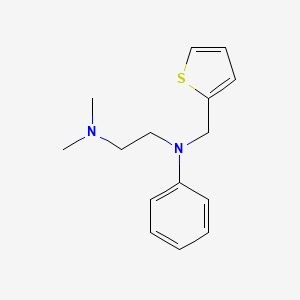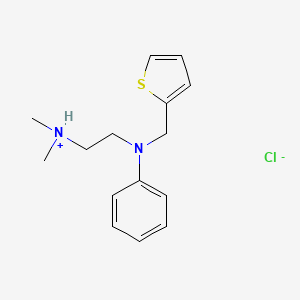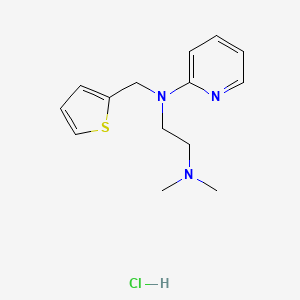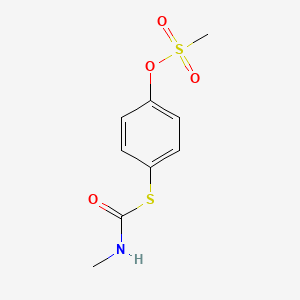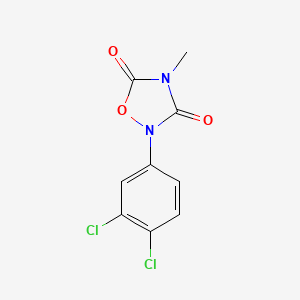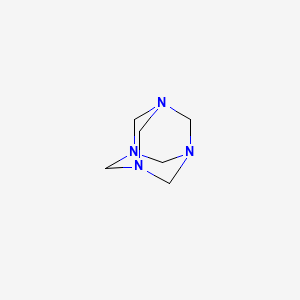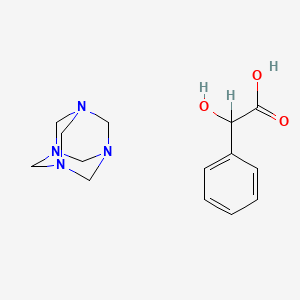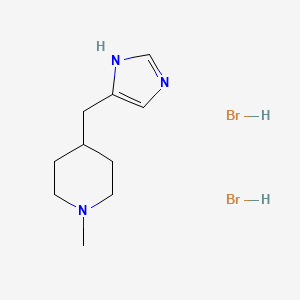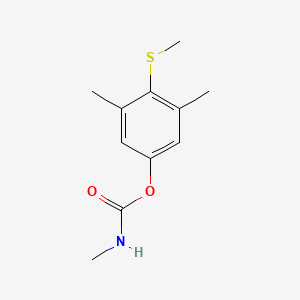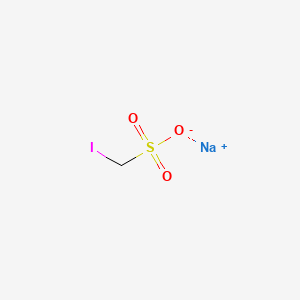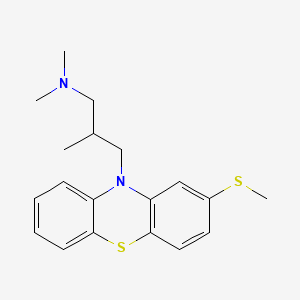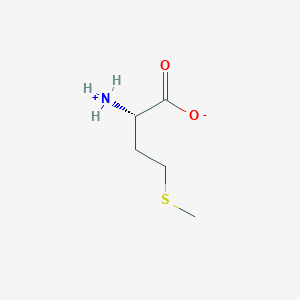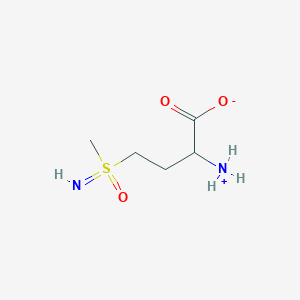
Méthyldopa
Vue d'ensemble
Description
La méthyldopa, connue chimiquement sous le nom de L-α-méthyl-3,4-dihydroxyphénylalanine, est un médicament principalement utilisé pour gérer l'hypertension artérielle. Elle a été introduite pour la première fois en 1960 et est reconnue pour son efficacité dans le traitement de l'hypertension, en particulier chez les femmes enceintes. La this compound figure sur la Liste des Médicaments Essentiels de l'Organisation Mondiale de la Santé en raison de son importance dans les soins de santé .
Mécanisme D'action
Target of Action
Methyldopa primarily targets the alpha (α)-2 adrenergic receptors in the brain . These receptors play a crucial role in regulating the outflow of adrenergic neurons, which are involved in various physiological processes, including the regulation of blood pressure .
Mode of Action
Methyldopa acts as an agonist at the alpha (α)-2 adrenergic receptors . By binding to these receptors, Methyldopa inhibits the outflow of adrenergic neurons, leading to a reduction in vasoconstrictor adrenergic signals . This interaction results in the dilation of blood vessels and a decrease in blood pressure .
Biochemical Pathways
Methyldopa is part of the biosynthetic pathway that leads to the synthesis of norepinephrine . It is converted into alpha-methyl dopamine by the action of the Dopa-decarboxylase enzyme, which is then transformed into alpha-methyl norepinephrine by the beta-hydroxylating enzyme . This process affects the concentration of various neurotransmitters in the tissue, including serotonin, dopamine, norepinephrine, and epinephrine .
Pharmacokinetics
Methyldopa is a prodrug, meaning it requires biotransformation to an active metabolite for therapeutic effects . It is metabolized to its active form, alpha-methylnorepinephrine, via dopamine beta-hydroxylase activity . The pharmacokinetic properties of Methyldopa, including its absorption, distribution, metabolism, and excretion (ADME), impact its bioavailability and therapeutic efficacy .
Result of Action
The molecular and cellular effects of Methyldopa’s action primarily involve a decrease in peripheral sympathetic tone and a reduction in arterial pressure . This is achieved through the action of its active metabolite, alpha-methylnorepinephrine, which works as an agonist at central inhibitory alpha-adrenergic receptors .
Action Environment
Environmental factors can influence the action, efficacy, and stability of Methyldopa. For instance, the presence of certain substances in the environment, such as other medications, vitamins, or herbs, can interact with Methyldopa and potentially alter its effectiveness . Additionally, the physiological environment within the body, including the status of the liver and kidneys, can impact the metabolism and excretion of Methyldopa .
Applications De Recherche Scientifique
Methyldopa has a wide range of applications in scientific research:
Chemistry: It is used as a reagent in various analytical techniques, including spectrophotometry and chromatography.
Medicine: Methyldopa is extensively used in the treatment of hypertension, particularly in pregnant women.
Industry: Methyldopa is used in the pharmaceutical industry for the production of antihypertensive medications.
Analyse Biochimique
Biochemical Properties
Methyldopa works by binding to alpha (α)-2 adrenergic receptors as an agonist, leading to the inhibition of adrenergic neuronal outflow and reduction of vasoconstrictor adrenergic signals . Methyldopa exists in two isomers D-α-methyldopa and L-α-methyldopa, which is the active form .
Cellular Effects
Methyldopa has a significant impact on various types of cells and cellular processes. It influences cell function by reducing the activity of the sympathetic nervous system . This reduction in activity leads to a decrease in blood pressure, making methyldopa an effective treatment for hypertension .
Molecular Mechanism
The molecular mechanism of methyldopa involves its binding to alpha (α)-2 adrenergic receptors as an agonist . This binding leads to the inhibition of adrenergic neuronal outflow and a reduction in vasoconstrictor adrenergic signals . This mechanism is how methyldopa exerts its effects at the molecular level.
Temporal Effects in Laboratory Settings
The plasma half-life of methyldopa is approximately 105 minutes . Following intravenous injection, the plasma half-life of methyldopa ranges from 90 to 127 minutes . This indicates that the effects of methyldopa can change over time in laboratory settings.
Dosage Effects in Animal Models
While specific studies on the dosage effects of methyldopa in animal models are limited, it is known that methyldopa is used to manage hypertension in clinical settings
Metabolic Pathways
Methyldopa is metabolised by dopamine hydroxylase (DBH) to its active metabolite β-methylnorepinephrine . This metabolite acts as an agonist at the pre-synaptic 2 adrenergic α α receptors in the brainstem, resulting in a reduced adrenergic neuronal outflow through the peripheral nervous system causing vasodilation and reduced blood pressure .
Transport and Distribution
While specific information on the transport and distribution of methyldopa within cells and tissues is limited, it is known that methyldopa works by binding to alpha (α)-2 adrenergic receptors as an agonist . This binding leads to the inhibition of adrenergic neuronal outflow and reduction of vasoconstrictor adrenergic signals .
Subcellular Localization
Given that methyldopa is a centrally acting sympatholytic agent and an antihypertensive agent , it is likely that it interacts with receptors and other structures within cells to exert its effects
Méthodes De Préparation
Voies de Synthèse et Conditions de Réaction : La méthyldopa peut être synthétisée par plusieurs méthodes. Une voie de synthèse courante implique la réaction du 3,4-dihydroxybenzaldéhyde avec le nitrométhane pour former du 3,4-dihydroxy-β-nitrostyrène. Cet intermédiaire est ensuite réduit en 3,4-dihydroxyphénylacétaldéhyde, qui subit une amination réductrice avec la méthylamine pour donner la this compound .
Méthodes de Production Industrielle : Dans les milieux industriels, la this compound est souvent produite par un procédé de séchage fluidisé. Cela implique la polymérisation de la this compound avec de l'alcool stéarylique et de la silice, ce qui donne une composition avec une fluidité et une compressibilité améliorées. Cette méthode améliore la stabilité et la durée de vie du produit final .
Analyse Des Réactions Chimiques
Types de Réactions : La méthyldopa subit diverses réactions chimiques, notamment l'oxydation, la réduction et la substitution.
Réactifs et Conditions Communs :
Réduction : La réduction de la this compound peut être réalisée en utilisant de l'hydrogène gazeux en présence d'un catalyseur de palladium.
Principaux Produits Formés : Les principaux produits formés à partir de ces réactions comprennent divers dérivés de la this compound, tels que l'α-méthyl norépinéphrine, qui est un métabolite actif de la this compound .
4. Applications de la Recherche Scientifique
La this compound a un large éventail d'applications dans la recherche scientifique :
Médecine : La this compound est largement utilisée dans le traitement de l'hypertension, en particulier chez les femmes enceintes.
Industrie : La this compound est utilisée dans l'industrie pharmaceutique pour la production de médicaments antihypertenseurs.
5. Mécanisme d'Action
La this compound est un agoniste alpha-2 adrénergique à action centrale. Elle est métabolisée dans l'organisme en α-méthyl norépinéphrine, qui stimule les récepteurs alpha-2 adrénergiques du système nerveux central. Cela conduit à une réduction de l'activité du système nerveux sympathique, entraînant une diminution de la résistance vasculaire et une baisse de la pression artérielle . La this compound inhibe également la décarboxylation de la dopa en dopamine, contribuant à ses effets antihypertenseurs .
Comparaison Avec Des Composés Similaires
La méthyldopa est souvent comparée à d'autres agents antihypertenseurs tels que le lisinopril, l'amlodipine, le labetalol, la nifédipine, l'hydralazine, la clonidine et le furosémide .
Unicité :
This compound vs. Lisinopril : Bien que les deux soient utilisés pour gérer l'hypertension, la this compound est préférée chez les femmes enceintes en raison de son profil de sécurité, tandis que le lisinopril est un inhibiteur de l'enzyme de conversion de l'angiotensine avec un mécanisme d'action différent.
This compound vs. Amlodipine : L'amlodipine est un bloqueur des canaux calciques, tandis que la this compound agit au niveau central sur les récepteurs alpha-2 adrénergiques.
This compound vs. Labetalol : Le labetalol est un bêtabloqueur avec une activité alpha-bloquante, ce qui le rend adapté aux urgences hypertensives, tandis que la this compound est principalement utilisée pour la gestion de l'hypertension chronique.
Composés Similaires :
- Lisinopril
- Amlodipine
- Labetalol
- Nifédipine
- Hydralazine
- Clonidine
- Furosémide
Le mécanisme d'action unique de la this compound et son profil de sécurité, en particulier pendant la grossesse, la distinguent des autres agents antihypertenseurs.
Propriétés
IUPAC Name |
(2S)-2-amino-3-(3,4-dihydroxyphenyl)-2-methylpropanoic acid | |
|---|---|---|
| Source | PubChem | |
| URL | https://pubchem.ncbi.nlm.nih.gov | |
| Description | Data deposited in or computed by PubChem | |
InChI |
InChI=1S/C10H13NO4/c1-10(11,9(14)15)5-6-2-3-7(12)8(13)4-6/h2-4,12-13H,5,11H2,1H3,(H,14,15)/t10-/m0/s1 | |
| Source | PubChem | |
| URL | https://pubchem.ncbi.nlm.nih.gov | |
| Description | Data deposited in or computed by PubChem | |
InChI Key |
CJCSPKMFHVPWAR-JTQLQIEISA-N | |
| Source | PubChem | |
| URL | https://pubchem.ncbi.nlm.nih.gov | |
| Description | Data deposited in or computed by PubChem | |
Canonical SMILES |
CC(CC1=CC(=C(C=C1)O)O)(C(=O)O)N | |
| Source | PubChem | |
| URL | https://pubchem.ncbi.nlm.nih.gov | |
| Description | Data deposited in or computed by PubChem | |
Isomeric SMILES |
C[C@](CC1=CC(=C(C=C1)O)O)(C(=O)O)N | |
| Source | PubChem | |
| URL | https://pubchem.ncbi.nlm.nih.gov | |
| Description | Data deposited in or computed by PubChem | |
Molecular Formula |
C10H13NO4 | |
| Record name | METHYL DOPA | |
| Source | CAMEO Chemicals | |
| URL | https://cameochemicals.noaa.gov/chemical/20642 | |
| Description | CAMEO Chemicals is a chemical database designed for people who are involved in hazardous material incident response and planning. CAMEO Chemicals contains a library with thousands of datasheets containing response-related information and recommendations for hazardous materials that are commonly transported, used, or stored in the United States. CAMEO Chemicals was developed by the National Oceanic and Atmospheric Administration's Office of Response and Restoration in partnership with the Environmental Protection Agency's Office of Emergency Management. | |
| Explanation | CAMEO Chemicals and all other CAMEO products are available at no charge to those organizations and individuals (recipients) responsible for the safe handling of chemicals. However, some of the chemical data itself is subject to the copyright restrictions of the companies or organizations that provided the data. | |
| Source | PubChem | |
| URL | https://pubchem.ncbi.nlm.nih.gov | |
| Description | Data deposited in or computed by PubChem | |
Related CAS |
27289-76-5 | |
| Record name | L-Tyrosine, 3-hydroxy-α-methyl-, homopolymer | |
| Source | CAS Common Chemistry | |
| URL | https://commonchemistry.cas.org/detail?cas_rn=27289-76-5 | |
| Description | CAS Common Chemistry is an open community resource for accessing chemical information. Nearly 500,000 chemical substances from CAS REGISTRY cover areas of community interest, including common and frequently regulated chemicals, and those relevant to high school and undergraduate chemistry classes. This chemical information, curated by our expert scientists, is provided in alignment with our mission as a division of the American Chemical Society. | |
| Explanation | The data from CAS Common Chemistry is provided under a CC-BY-NC 4.0 license, unless otherwise stated. | |
DSSTOX Substance ID |
DTXSID5023295 | |
| Record name | (-)-Methyldopa | |
| Source | EPA DSSTox | |
| URL | https://comptox.epa.gov/dashboard/DTXSID5023295 | |
| Description | DSSTox provides a high quality public chemistry resource for supporting improved predictive toxicology. | |
Molecular Weight |
211.21 g/mol | |
| Source | PubChem | |
| URL | https://pubchem.ncbi.nlm.nih.gov | |
| Description | Data deposited in or computed by PubChem | |
Physical Description |
Methyl dopa appears as colorless or almost colorless crystals or white to yellowish-white fine powder. Almost tasteless. In the sesquihydrate form. pH (saturated aqueous solution) about 5.0. (NTP, 1992), Solid | |
| Record name | METHYL DOPA | |
| Source | CAMEO Chemicals | |
| URL | https://cameochemicals.noaa.gov/chemical/20642 | |
| Description | CAMEO Chemicals is a chemical database designed for people who are involved in hazardous material incident response and planning. CAMEO Chemicals contains a library with thousands of datasheets containing response-related information and recommendations for hazardous materials that are commonly transported, used, or stored in the United States. CAMEO Chemicals was developed by the National Oceanic and Atmospheric Administration's Office of Response and Restoration in partnership with the Environmental Protection Agency's Office of Emergency Management. | |
| Explanation | CAMEO Chemicals and all other CAMEO products are available at no charge to those organizations and individuals (recipients) responsible for the safe handling of chemicals. However, some of the chemical data itself is subject to the copyright restrictions of the companies or organizations that provided the data. | |
| Record name | Methyldopa | |
| Source | Human Metabolome Database (HMDB) | |
| URL | http://www.hmdb.ca/metabolites/HMDB0011754 | |
| Description | The Human Metabolome Database (HMDB) is a freely available electronic database containing detailed information about small molecule metabolites found in the human body. | |
| Explanation | HMDB is offered to the public as a freely available resource. Use and re-distribution of the data, in whole or in part, for commercial purposes requires explicit permission of the authors and explicit acknowledgment of the source material (HMDB) and the original publication (see the HMDB citing page). We ask that users who download significant portions of the database cite the HMDB paper in any resulting publications. | |
Solubility |
>31.7 [ug/mL] (The mean of the results at pH 7.4), 1 to 10 mg/mL at 73 °F (NTP, 1992), Sol in water @ 25 °C: approx 10 mg/ml /D-form/, Sol in water @ 25 °C: approx 18 mg/ml /DL-form/, In water @ 25 °C: about 10 mg/ml; practically insol in common org solvents; sol in dil mineral acids, Soluble in isopropanol, ethanol, and water., 10mg/mL at 25 °C | |
| Record name | SID8139902 | |
| Source | Burnham Center for Chemical Genomics | |
| URL | https://pubchem.ncbi.nlm.nih.gov/bioassay/1996#section=Data-Table | |
| Description | Aqueous solubility in buffer at pH 7.4 | |
| Record name | METHYL DOPA | |
| Source | CAMEO Chemicals | |
| URL | https://cameochemicals.noaa.gov/chemical/20642 | |
| Description | CAMEO Chemicals is a chemical database designed for people who are involved in hazardous material incident response and planning. CAMEO Chemicals contains a library with thousands of datasheets containing response-related information and recommendations for hazardous materials that are commonly transported, used, or stored in the United States. CAMEO Chemicals was developed by the National Oceanic and Atmospheric Administration's Office of Response and Restoration in partnership with the Environmental Protection Agency's Office of Emergency Management. | |
| Explanation | CAMEO Chemicals and all other CAMEO products are available at no charge to those organizations and individuals (recipients) responsible for the safe handling of chemicals. However, some of the chemical data itself is subject to the copyright restrictions of the companies or organizations that provided the data. | |
| Record name | Methyldopa | |
| Source | DrugBank | |
| URL | https://www.drugbank.ca/drugs/DB00968 | |
| Description | The DrugBank database is a unique bioinformatics and cheminformatics resource that combines detailed drug (i.e. chemical, pharmacological and pharmaceutical) data with comprehensive drug target (i.e. sequence, structure, and pathway) information. | |
| Explanation | Creative Common's Attribution-NonCommercial 4.0 International License (http://creativecommons.org/licenses/by-nc/4.0/legalcode) | |
| Record name | METHYLDOPA | |
| Source | Hazardous Substances Data Bank (HSDB) | |
| URL | https://pubchem.ncbi.nlm.nih.gov/source/hsdb/218 | |
| Description | The Hazardous Substances Data Bank (HSDB) is a toxicology database that focuses on the toxicology of potentially hazardous chemicals. It provides information on human exposure, industrial hygiene, emergency handling procedures, environmental fate, regulatory requirements, nanomaterials, and related areas. The information in HSDB has been assessed by a Scientific Review Panel. | |
| Record name | Methyldopa | |
| Source | Human Metabolome Database (HMDB) | |
| URL | http://www.hmdb.ca/metabolites/HMDB0011754 | |
| Description | The Human Metabolome Database (HMDB) is a freely available electronic database containing detailed information about small molecule metabolites found in the human body. | |
| Explanation | HMDB is offered to the public as a freely available resource. Use and re-distribution of the data, in whole or in part, for commercial purposes requires explicit permission of the authors and explicit acknowledgment of the source material (HMDB) and the original publication (see the HMDB citing page). We ask that users who download significant portions of the database cite the HMDB paper in any resulting publications. | |
Mechanism of Action |
The exact mechanism of methyldopa is not fully elucidated; however, the main mechanisms of methyldopa involve its actions on alpha-adrenergic receptor and the aromatic L-amino acid decarboxylase enzyme, to a lesser extent. The sympathetic outflow is regulated by alpha (α)-2 adrenergic receptors and imidazoline receptors expressed on adrenergic neurons within the rostral ventrolateral medulla. Methyldopa is metabolized to α‐methylnorepinephrine via dopamine beta-hydroxylase activity and, consequently, alpha-methylepinephrine via phenylethanolamine-N-methyltransferase activity. Mediating the therapeutic effects of methyldopa, α‐methylnorepinephrine and α-methylepinephrine active metabolites are agonists at presynaptic alpha-2 adrenergic receptors in the brainstem. Stimulating alpha-2 adrenergic receptors results in the inhibition of adrenergic neuronal outflow and attenuation of norepinephrine release in the brainstem. Consequently, the output of vasoconstrictor adrenergic signals to the peripheral sympathetic nervous system is reduced, leading to a reduction in blood pressure. The L-isomer of alpha-methyldopa also reduces blood pressure by inhibiting aromatic L-amino acid decarboxylase, also known as DOPA decarboxylase, which is an enzyme responsible for the syntheses of dopamine and serotonin. Inhibiting this enzyme leads to depletion of biogenic amines such as norepinephrine. However, inhibition of aromatic L-amino acid decarboxylase plays a minimal role in the blood-pressure‐lowering effect of methyldopa., METHYLDOPA...HAS HYPOTENSIVE ACTION INDEPENDENT OF ITS ANTIADRENERGIC ACTIONS; THIS IS PROBABLY PARTLY CENTRAL DEPRESSANT ACTION @ VASOMOTOR CENTER & PARTLY PERIPHERAL ACTION OF UNKNOWN MECHANISM., ... Alpha-methylnorepinephrine acts in the brain to inhibit adrenergic neuronal outflow from the brainstem, and this central effect is principally responsible for its antihypertensive action., IN CONSCIOUS RENAL HYPERTENSIVE RATS ALPHA-METHYLDOPA PRODUCED A LONG-LASTING FALL IN BLOOD PRESSURE WHICH WAS PARTIALLY ATTENUATED BY PRETREATMENT WITH NALTREXONE (5 MG/KG SC). PRETREATMENT WITH ANTISERUM TO BETA-ENDORPHIN APPLIED LOCALLY, ALSO BLOCKED THE DEPRESSOR RESPONSE. THESE RESULTS SUGGEST THAT THE FALL IN BLOOD PRESSURE OBSERVED AFTER ALPHA-METHYLDOPA AND ITS ACTIVE METABOLITE ALPHA-METHYLNORADRENALINE INVOLVES A BETA-ENDORPHIN LIKE PEPTIDE; A POSSIBLE SITE OF ACTION IS THE NUCLEUS TRACTUS SOLITARII., A REVIEW ON THE MECHANISM OF ACTION. | |
| Record name | Methyldopa | |
| Source | DrugBank | |
| URL | https://www.drugbank.ca/drugs/DB00968 | |
| Description | The DrugBank database is a unique bioinformatics and cheminformatics resource that combines detailed drug (i.e. chemical, pharmacological and pharmaceutical) data with comprehensive drug target (i.e. sequence, structure, and pathway) information. | |
| Explanation | Creative Common's Attribution-NonCommercial 4.0 International License (http://creativecommons.org/licenses/by-nc/4.0/legalcode) | |
| Record name | METHYLDOPA | |
| Source | Hazardous Substances Data Bank (HSDB) | |
| URL | https://pubchem.ncbi.nlm.nih.gov/source/hsdb/218 | |
| Description | The Hazardous Substances Data Bank (HSDB) is a toxicology database that focuses on the toxicology of potentially hazardous chemicals. It provides information on human exposure, industrial hygiene, emergency handling procedures, environmental fate, regulatory requirements, nanomaterials, and related areas. The information in HSDB has been assessed by a Scientific Review Panel. | |
Color/Form |
Minute, anhyd crystals from methanol, WHITE TO YELLOWISH WHITE, FINE POWDER, WHICH MAY CONTAIN FRIABLE LUMPS | |
CAS No. |
555-30-6, 41372-08-1 | |
| Record name | METHYL DOPA | |
| Source | CAMEO Chemicals | |
| URL | https://cameochemicals.noaa.gov/chemical/20642 | |
| Description | CAMEO Chemicals is a chemical database designed for people who are involved in hazardous material incident response and planning. CAMEO Chemicals contains a library with thousands of datasheets containing response-related information and recommendations for hazardous materials that are commonly transported, used, or stored in the United States. CAMEO Chemicals was developed by the National Oceanic and Atmospheric Administration's Office of Response and Restoration in partnership with the Environmental Protection Agency's Office of Emergency Management. | |
| Explanation | CAMEO Chemicals and all other CAMEO products are available at no charge to those organizations and individuals (recipients) responsible for the safe handling of chemicals. However, some of the chemical data itself is subject to the copyright restrictions of the companies or organizations that provided the data. | |
| Record name | Methyldopa | |
| Source | CAS Common Chemistry | |
| URL | https://commonchemistry.cas.org/detail?cas_rn=555-30-6 | |
| Description | CAS Common Chemistry is an open community resource for accessing chemical information. Nearly 500,000 chemical substances from CAS REGISTRY cover areas of community interest, including common and frequently regulated chemicals, and those relevant to high school and undergraduate chemistry classes. This chemical information, curated by our expert scientists, is provided in alignment with our mission as a division of the American Chemical Society. | |
| Explanation | The data from CAS Common Chemistry is provided under a CC-BY-NC 4.0 license, unless otherwise stated. | |
| Record name | Methyldopa [INN] | |
| Source | ChemIDplus | |
| URL | https://pubchem.ncbi.nlm.nih.gov/substance/?source=chemidplus&sourceid=0000555306 | |
| Description | ChemIDplus is a free, web search system that provides access to the structure and nomenclature authority files used for the identification of chemical substances cited in National Library of Medicine (NLM) databases, including the TOXNET system. | |
| Record name | Methyldopa | |
| Source | DrugBank | |
| URL | https://www.drugbank.ca/drugs/DB00968 | |
| Description | The DrugBank database is a unique bioinformatics and cheminformatics resource that combines detailed drug (i.e. chemical, pharmacological and pharmaceutical) data with comprehensive drug target (i.e. sequence, structure, and pathway) information. | |
| Explanation | Creative Common's Attribution-NonCommercial 4.0 International License (http://creativecommons.org/licenses/by-nc/4.0/legalcode) | |
| Record name | methyldopa | |
| Source | DTP/NCI | |
| URL | https://dtp.cancer.gov/dtpstandard/servlet/dwindex?searchtype=NSC&outputformat=html&searchlist=760080 | |
| Description | The NCI Development Therapeutics Program (DTP) provides services and resources to the academic and private-sector research communities worldwide to facilitate the discovery and development of new cancer therapeutic agents. | |
| Explanation | Unless otherwise indicated, all text within NCI products is free of copyright and may be reused without our permission. Credit the National Cancer Institute as the source. | |
| Record name | L-Tyrosine, 3-hydroxy-.alpha.-methyl- | |
| Source | EPA Chemicals under the TSCA | |
| URL | https://www.epa.gov/chemicals-under-tsca | |
| Description | EPA Chemicals under the Toxic Substances Control Act (TSCA) collection contains information on chemicals and their regulations under TSCA, including non-confidential content from the TSCA Chemical Substance Inventory and Chemical Data Reporting. | |
| Record name | (-)-Methyldopa | |
| Source | EPA DSSTox | |
| URL | https://comptox.epa.gov/dashboard/DTXSID5023295 | |
| Description | DSSTox provides a high quality public chemistry resource for supporting improved predictive toxicology. | |
| Record name | Methyldopa | |
| Source | European Chemicals Agency (ECHA) | |
| URL | https://echa.europa.eu/substance-information/-/substanceinfo/100.008.264 | |
| Description | The European Chemicals Agency (ECHA) is an agency of the European Union which is the driving force among regulatory authorities in implementing the EU's groundbreaking chemicals legislation for the benefit of human health and the environment as well as for innovation and competitiveness. | |
| Explanation | Use of the information, documents and data from the ECHA website is subject to the terms and conditions of this Legal Notice, and subject to other binding limitations provided for under applicable law, the information, documents and data made available on the ECHA website may be reproduced, distributed and/or used, totally or in part, for non-commercial purposes provided that ECHA is acknowledged as the source: "Source: European Chemicals Agency, http://echa.europa.eu/". Such acknowledgement must be included in each copy of the material. ECHA permits and encourages organisations and individuals to create links to the ECHA website under the following cumulative conditions: Links can only be made to webpages that provide a link to the Legal Notice page. | |
| Record name | METHYLDOPA ANHYDROUS | |
| Source | FDA Global Substance Registration System (GSRS) | |
| URL | https://gsrs.ncats.nih.gov/ginas/app/beta/substances/M4R0H12F6M | |
| Description | The FDA Global Substance Registration System (GSRS) enables the efficient and accurate exchange of information on what substances are in regulated products. Instead of relying on names, which vary across regulatory domains, countries, and regions, the GSRS knowledge base makes it possible for substances to be defined by standardized, scientific descriptions. | |
| Explanation | Unless otherwise noted, the contents of the FDA website (www.fda.gov), both text and graphics, are not copyrighted. They are in the public domain and may be republished, reprinted and otherwise used freely by anyone without the need to obtain permission from FDA. Credit to the U.S. Food and Drug Administration as the source is appreciated but not required. | |
| Record name | METHYLDOPA | |
| Source | Hazardous Substances Data Bank (HSDB) | |
| URL | https://pubchem.ncbi.nlm.nih.gov/source/hsdb/218 | |
| Description | The Hazardous Substances Data Bank (HSDB) is a toxicology database that focuses on the toxicology of potentially hazardous chemicals. It provides information on human exposure, industrial hygiene, emergency handling procedures, environmental fate, regulatory requirements, nanomaterials, and related areas. The information in HSDB has been assessed by a Scientific Review Panel. | |
| Record name | Methyldopa | |
| Source | Human Metabolome Database (HMDB) | |
| URL | http://www.hmdb.ca/metabolites/HMDB0011754 | |
| Description | The Human Metabolome Database (HMDB) is a freely available electronic database containing detailed information about small molecule metabolites found in the human body. | |
| Explanation | HMDB is offered to the public as a freely available resource. Use and re-distribution of the data, in whole or in part, for commercial purposes requires explicit permission of the authors and explicit acknowledgment of the source material (HMDB) and the original publication (see the HMDB citing page). We ask that users who download significant portions of the database cite the HMDB paper in any resulting publications. | |
Melting Point |
572 °F approximately (decomposes) (NTP, 1992), >300, 300 °C | |
| Record name | METHYL DOPA | |
| Source | CAMEO Chemicals | |
| URL | https://cameochemicals.noaa.gov/chemical/20642 | |
| Description | CAMEO Chemicals is a chemical database designed for people who are involved in hazardous material incident response and planning. CAMEO Chemicals contains a library with thousands of datasheets containing response-related information and recommendations for hazardous materials that are commonly transported, used, or stored in the United States. CAMEO Chemicals was developed by the National Oceanic and Atmospheric Administration's Office of Response and Restoration in partnership with the Environmental Protection Agency's Office of Emergency Management. | |
| Explanation | CAMEO Chemicals and all other CAMEO products are available at no charge to those organizations and individuals (recipients) responsible for the safe handling of chemicals. However, some of the chemical data itself is subject to the copyright restrictions of the companies or organizations that provided the data. | |
| Record name | Methyldopa | |
| Source | DrugBank | |
| URL | https://www.drugbank.ca/drugs/DB00968 | |
| Description | The DrugBank database is a unique bioinformatics and cheminformatics resource that combines detailed drug (i.e. chemical, pharmacological and pharmaceutical) data with comprehensive drug target (i.e. sequence, structure, and pathway) information. | |
| Explanation | Creative Common's Attribution-NonCommercial 4.0 International License (http://creativecommons.org/licenses/by-nc/4.0/legalcode) | |
| Record name | Methyldopa | |
| Source | Human Metabolome Database (HMDB) | |
| URL | http://www.hmdb.ca/metabolites/HMDB0011754 | |
| Description | The Human Metabolome Database (HMDB) is a freely available electronic database containing detailed information about small molecule metabolites found in the human body. | |
| Explanation | HMDB is offered to the public as a freely available resource. Use and re-distribution of the data, in whole or in part, for commercial purposes requires explicit permission of the authors and explicit acknowledgment of the source material (HMDB) and the original publication (see the HMDB citing page). We ask that users who download significant portions of the database cite the HMDB paper in any resulting publications. | |
Retrosynthesis Analysis
AI-Powered Synthesis Planning: Our tool employs the Template_relevance Pistachio, Template_relevance Bkms_metabolic, Template_relevance Pistachio_ringbreaker, Template_relevance Reaxys, Template_relevance Reaxys_biocatalysis model, leveraging a vast database of chemical reactions to predict feasible synthetic routes.
One-Step Synthesis Focus: Specifically designed for one-step synthesis, it provides concise and direct routes for your target compounds, streamlining the synthesis process.
Accurate Predictions: Utilizing the extensive PISTACHIO, BKMS_METABOLIC, PISTACHIO_RINGBREAKER, REAXYS, REAXYS_BIOCATALYSIS database, our tool offers high-accuracy predictions, reflecting the latest in chemical research and data.
Strategy Settings
| Precursor scoring | Relevance Heuristic |
|---|---|
| Min. plausibility | 0.01 |
| Model | Template_relevance |
| Template Set | Pistachio/Bkms_metabolic/Pistachio_ringbreaker/Reaxys/Reaxys_biocatalysis |
| Top-N result to add to graph | 6 |
Feasible Synthetic Routes
A: α-Methyldopa is a centrally acting antihypertensive agent. It is converted to α-methylnorepinephrine in the brain, which then acts as an agonist at central α2-adrenergic receptors. [] This activation reduces sympathetic outflow from the brain, leading to a decrease in peripheral vascular resistance and blood pressure. [, , ]
A: While its primary action is central, α-Methyldopa does have some peripheral effects. Studies in rabbits suggest that about 70% of its action is central, while 30% is attributed to peripheral mechanisms. [] Peripherally, α-methylnorepinephrine can act as a false neurotransmitter, competing with norepinephrine at sympathetic nerve endings. This can contribute to its antihypertensive effect, particularly at lower frequencies of sympathetic nerve stimulation. [, ]
A: Research indicates that some of α-Methyldopa's central effects might be mediated through serotonin pathways. Experiments in rabbits showed that destroying serotonergic neurons with 5,6-dihydroxytryptamine attenuated the effects of centrally administered α-Methyldopa on mean arterial pressure and heart rate by approximately 50%. []
A: Studies suggest that β-adrenergic receptor stimulation might play a role in the overall effects of α-Methyldopa. Metabolites of α-Methyldopa have shown high potency in competing for β1 receptors in the forebrain. Additionally, (-)-erythro-α-methylepinephrine, a α-Methyldopa metabolite, displayed a higher potency than (-)-epinephrine, (-)-norepinephrine, and (-)-erythro-α-methylnorepinephrine in competing for β2 receptors on human lymphocytes. []
A: The molecular formula of α-Methyldopa sesquihydrate is C10H13NO4 · 1½H2O. Its molecular weight is 238.24 g/mol. []
A: α-Methyldopa itself is a prodrug, meaning it is metabolized in the body to its active form, α-methylnorepinephrine. This metabolite is structurally similar to norepinephrine, allowing it to interact with adrenergic receptors. The α-methyl group is crucial for its central activity and reduces its potency at peripheral adrenergic receptors compared to norepinephrine. [, ]
A: One challenge in formulating α-Methyldopa is its susceptibility to oxidation. [] Exposure to air, light, and high pH can degrade the drug, leading to changes in color and efficacy.
A: α-Methyldopa is well absorbed after oral administration. It is primarily metabolized in the liver and central nervous system to α-methyldopamine and α-methylnorepinephrine. [, , ]
A: α-Methyldopa and its metabolites are mainly excreted in the urine. [, , ] Studies in neonates showed that α-Methyldopa is readily metabolized to α-methyldopa sulfate, and both are excreted slowly compared to adults, resulting in a longer half-life. []
A: Studies indicate a potential for dose-dependent metabolism of α-Methyldopa. Research in Parkinson's disease patients revealed that the proportion of the dose excreted as vanillacetic acid (VLA) increased linearly with increasing α-Methyldopa dosage. This suggests a potential induction of the transaminase enzyme involved in its metabolism. []
A: Yes, α-Methyldopa has been shown to interact with iron supplementation. α-Methyldopa can form complexes with both ferrous and ferric iron. This interaction is pH-dependent, with complex formation being faster at higher pH levels. The tight binding of ferric iron to α-Methyldopa can potentially alter the drug's biodistribution. Furthermore, under the acidic conditions of the stomach, redox cycling can occur, leading to both catechol oxidation and the production of potentially harmful hydroxyl radicals. Therefore, caution is advised when administering α-Methyldopa concurrently with ferrous sulfate. []
A: α-Methyldopa consistently demonstrated antihypertensive effects in various animal models. In spontaneously hypertensive rats (SHR), both long-term intravenous infusions and prolonged oral administration of α-Methyldopa significantly reduced mean arterial pressure. [, ] These effects are consistent with its mechanism of action, primarily involving the central nervous system.
A: Research suggests that α-Methyldopa might have a beneficial effect on cardiac hypertrophy associated with hypertension. In SHR, prolonged treatment with α-Methyldopa resulted in significantly reduced cardiac masses and heart weight-to-body weight ratios compared to untreated controls. Interestingly, this effect was not observed with clonidine, another centrally acting antihypertensive. [] Furthermore, α-Methyldopa also reduced cardiac mass in normotensive Wistar Kyoto rats without significantly affecting systemic hemodynamics, suggesting a potential direct effect on cardiac hypertrophy beyond blood pressure reduction. []
A: α-Methyldopa has been associated with several side effects, including drowsiness, dry mouth, headache, and dizziness. [, , ] In rare cases, it can also cause more serious adverse effects like liver damage and hemolytic anemia. [, , ]
A: The impact of α-Methyldopa on GH secretion appears to be more complex and potentially time-dependent. While short-term α-Methyldopa treatment in hypertensive patients did not significantly affect GH levels during an insulin stimulation test, there are suggestions that long-term treatment might have different effects. [] One hypothesis is that the time course of α-Methyldopa's effect on GH secretion might be related to the gradual substitution of endogenous catecholamines with α-Methyldopa metabolites within the brain. []
A: Liquid chromatography (LC) is a commonly used method for determining α-Methyldopa concentrations in both pharmaceutical formulations and biological samples. [] Reverse-phase C18 columns, coupled with UV detection, have been successfully employed for this purpose. This method offers high sensitivity and can also be used to quantify α-Methyldopa in combination with other drugs like hydrochlorothiazide and chlorothiazide. []
A: Yes, spectrophotometric methods based on charge-transfer complexation can be used for the determination of α-Methyldopa in pharmaceutical formulations. [] One such method utilizes bromanil as a complexing agent, resulting in a green-colored product with maximum absorbance at 738 nm. This method offers a simple, rapid, and cost-effective approach for α-Methyldopa quantification. []
A: α-Methyldopa has been associated with the development of autoimmune hemolytic anemia in some patients, although this is a rare side effect. [, ] The mechanism is not fully understood, but it is thought to involve the production of autoantibodies against red blood cells. []
A: Research suggests that α-Methyldopa metabolism might involve COMT. Experiments using dopacetamide, a COMT inhibitor, revealed alterations in the urinary excretion profile of α-Methyldopa metabolites in rats. Dopacetamide administration led to an increase in the urinary content of 14C-3,4-dihydroxyphenylacetic acid and 14C-dopamine, while decreasing 14C-3-methoxytyramine levels. [] This observation suggests that COMT might play a role in the O-methylation pathway of α-Methyldopa metabolism.
ANone: Several alternative antihypertensive medications are available, each with its own mechanism of action and side effect profile. Some commonly used alternatives include:
- Beta-blockers (e.g., metoprolol, propranolol, labetalol): These drugs block the effects of adrenaline on the heart and blood vessels, leading to a decrease in heart rate and blood pressure. [, , , ]
- Calcium channel blockers (e.g., nifedipine, diltiazem): These medications relax and widen blood vessels by blocking the entry of calcium into muscle cells lining the vessel walls. [, ]
- ACE inhibitors (e.g., captopril): These drugs block the action of angiotensin-converting enzyme (ACE), an enzyme that produces angiotensin II, a potent vasoconstrictor. []
Avertissement et informations sur les produits de recherche in vitro
Veuillez noter que tous les articles et informations sur les produits présentés sur BenchChem sont destinés uniquement à des fins informatives. Les produits disponibles à l'achat sur BenchChem sont spécifiquement conçus pour des études in vitro, qui sont réalisées en dehors des organismes vivants. Les études in vitro, dérivées du terme latin "in verre", impliquent des expériences réalisées dans des environnements de laboratoire contrôlés à l'aide de cellules ou de tissus. Il est important de noter que ces produits ne sont pas classés comme médicaments et n'ont pas reçu l'approbation de la FDA pour la prévention, le traitement ou la guérison de toute condition médicale, affection ou maladie. Nous devons souligner que toute forme d'introduction corporelle de ces produits chez les humains ou les animaux est strictement interdite par la loi. Il est essentiel de respecter ces directives pour assurer la conformité aux normes légales et éthiques en matière de recherche et d'expérimentation.


